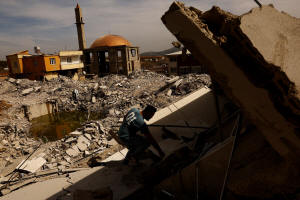Turks ask how a boom town came crashing down in quake
 Send a link to a friend
Send a link to a friend
 [March 06, 2023]
By Can Sezer and Jonathan Spicer [March 06, 2023]
By Can Sezer and Jonathan Spicer
NURDAGI, Turkey (Reuters) - Almost every apartment tower in Nurdagi
collapsed or was shattered beyond repair in last month's earthquake in
Turkey - and people are now asking if a building boom in the town in
recent decades may have to led to the deaths of thousands of residents.
The town's population swelled in recent years to some 25,000, residents
say, driven in part by increasingly flexible regulations that allowed
apartment blocks to reach as high as eight stories, from a limit of
three previously.
"We shouldn't have had more than two to three floors here. This
20-year-long rapid construction came crashing down in just two minutes,"
said Hasan Bal, 52, a retired teacher who lost 10 immediate relatives in
the magnitude 7.8 quake.
"We expected an earthquake but not such a thing as that...the ground
rose 1-1.5 meters like a wave," said Bal, the local representative for
the opposition DEVA party.
"Even if some of the standards required in the earthquake belt are met,
buildings had no chance to withstand it."
The mayor, who hails from President Tayyip Erdogan's ruling AK Party,
has been arrested over allegations that past construction work may have
been substandard.

The initial quake on Feb. 6 tremor sliced directly through Nurdagi,
leaving it among the worst hit communities in Turkey's deadliest modern
disaster.
The quake and aftershocks also flattened much larger centers including
Antakya city to the south.
Residents say cheap credit had helped the town expand, reflecting a
nationwide building boom that has defined Erdogan's two decades in
power.
But Nurdagi sits atop a known faultline, mostly on flat valley terrain
offering little protection from seismic waves.
Since 2004, the municipality allowed apartments to reach first five
stories then eight, three residents said. By this year, the town had
11,000 total buildings, the urbanisation ministry said.
State-owned news agency Anadolu said Mayor Okkes Kavak was arrested and
replaced two weeks ago over construction practices and a local developer
was also arrested.
The municipality did not respond to a query about how buildings were
allowed to grow over the years.
[to top of second column]
|

Ibrahim Kurt helps salvage belongings
from a collapsed home in the aftermath of a deadly earthquake in
Nurdagi, Turkey, March 5, 2023. REUTERS/Susana Vera

SURVIVAL AND LOSS
A month after the quakes, the many dozens of apartment towers that
are not already heaps of twisted steel and concrete are being torn
down. An estimated 4,000 people died in Nurdagi, and the survivors
who remained live mostly in tents.
For five days after the tremor, Havva Aslan and her husband and
three children survived under the concrete rubble of a five-storey
building where they had lived on the first floor.
"We've lost everything else but not each other," she told Reuters of
the morning that their apartment floor gave way, leaving them
trapped together in the darkness.
Aslan said her family is thankful for a furnished container home
where they live for now on the outskirts of town.
"We may perhaps build our two-storey home back at the village once
all this is over," she said.
Urbanisation Minister Murat Kurum said some parts of Nurdagi will be
relocated to higher, sturdier ground. Erdogan, facing an election in
May, has promised to rebuild the entire disaster zone within a year.
But many local people want a more wholesale reconsideration of
plans.
"The correct policy is that no building should exceed two storeys,"
said Fatih Cihan, 42, a farmer in Nurdagi and former assistant
professor of finance and statistics at the University of
Connecticut.
Having driven his family to Istanbul immediately after the quake, he
returned and now lives in a tent. He said he lost machinery and the
irrigation system for his 100-acre farm in the fallout.
"The first two weeks I just stared at my land," Cihan said. "I saw
my life collapse before my eyes."
(Editing by Angus MacSwan)
[© 2023 Thomson Reuters. All rights
reserved.]This material may not be published,
broadcast, rewritten or redistributed.
Thompson Reuters is solely responsible for this content.
 |